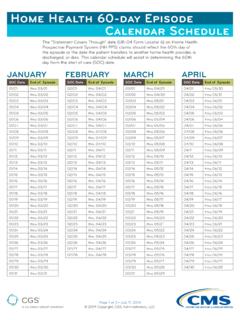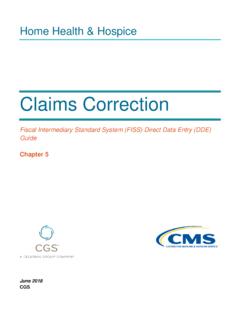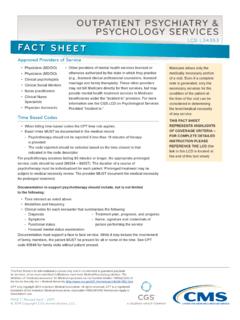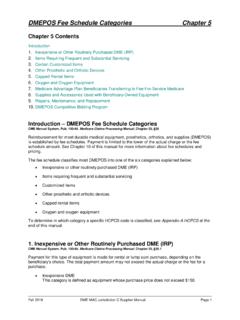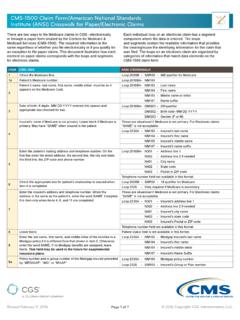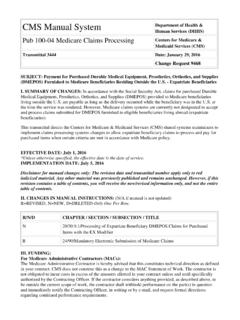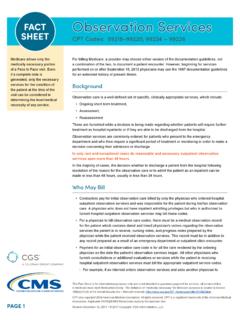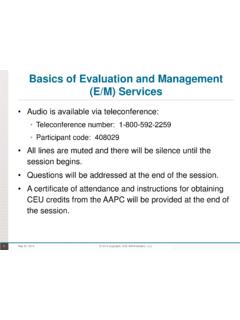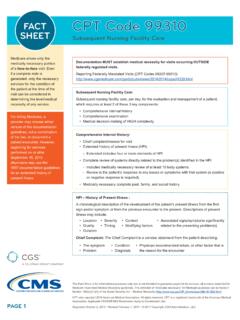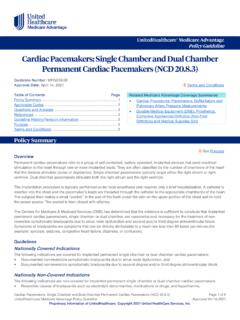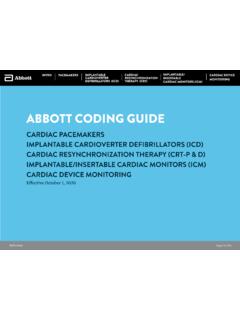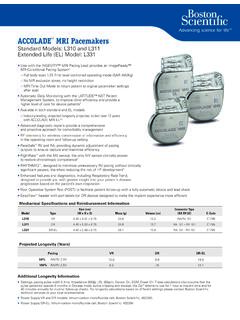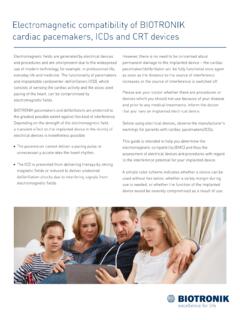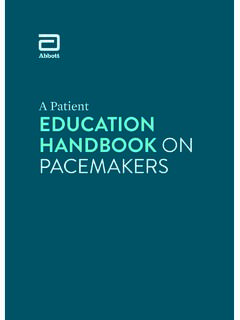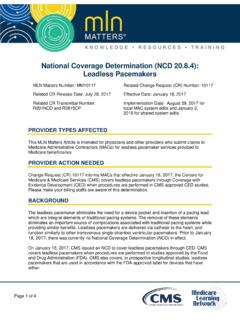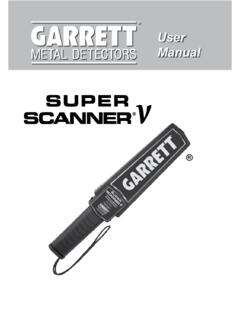Transcription of Dual Chamber Pacemakers: Fact Sheet - CGS Medicare
1 dual - Chamber Pacemakers: fact SheetBackgroundCMS issued a National Coverage Determination (NCD) regarding pacemakers, most recently revised in 2004, which defines the indications for single- Chamber and dual - Chamber pacemakers. A significant number of cases have been seen in which a dual - Chamber pacemaker was implanted in a patient who had an indication for only a single- Chamber device. This fact Sheet describes common errors and lists the indications and contraindications for dual - Chamber dual - Chamber pacemaker ErrorsErrorExplanationNo documentation to support the choice of a dual - Chamber rather than a single- Chamber NCD lists covered indications for both single- and dual - Chamber the record does not support the medical necessity of the dual Chamber pacemaker , the services are pacemaker implantation in patients with a clear contraindication.
2 Such as chronic atrial NCD lists contraindications for dual - Chamber physician s rationale for choosing a dual - Chamber pacemaker rather than a single- Chamber pacemaker must be clearly documented in the patient s medical to the CMS NCD for Cardiac Pacemakers (CMS National Coverage Determination manual (Pub. 100-03), part 1, chapter 1, section , ) for complete, current guidance regarding coverage of cardiac pacemakers. We are providing the following information, excerpted from the NCD, as a Covered Indications for dual Chamber Pacemakers1. Patients in whom single- Chamber (ventricular pacing) at the time of pacemaker insertion elicits a definite drop in blood pressure, retrograde conduction, or discomfort;2.
3 Patients in whom the pacemaker syndrome (atrial ventricular asynchrony), with significant symptoms, has already been experienced with a pacemaker that is being replaced;3. Patients in whom even a relatively small increase in cardiac efficiency will importantly improve the quality of life ( , patients with congestive heart failure despite adequate other medical measures); or4. Patients in whom the pacemaker syndrome can be anticipated ( , in young and active people, etc.). dual - Chamber pacemakers may also be covered for the conditions (defined as Group in the Medicare NCD Manual), if the medical necessity is sufficiently justified through adequate claims development. Expert physicians differ in their judgments about what constitutes appropriate criteria for dual - Chamber pacemaker use.
4 The judgment is that such a pacemaker is warranted in the patient meeting accepted criteria must be based upon the individual needs and characteristics of that patient, weighing the magnitude and likelihood of anticipated benefits against the magnitude and likelihood of disadvantages to the patient. 2014 Copyright, CGS Administrators, LLC. Version 1 r Page 1 of 4 dual - Chamber Pacemakers: fact Sheet 2014 Copyright, CGS Administrators, 1 r Page 2 of 4 The following are conditions under which cardiac pacing is generally considered acceptable or necessary, provided that the conditions are chronic or recurrent and not due to transient causes such as acute myocardial infarction, drug toxicity, or electrolyte imbalance (in cases where there is a rhythm disturbance, if the rhythm disturbance is chronic or recurrent, a single episode of a symptom such as syncope or seizure is adequate to establish medical necessity):1.
5 Acquired complete (also referred to as third-degree) atrioventricular (AV) heart block;2. Congenital complete heart block with severe bradycardia (in relation to age), or significant physiological deficits or significant symptoms due to the bradycardia;3. Second-degree AV heart block of Type II of P-R interval prior to each blocked beat. P-R interval indicates the time taken for an impulse to travel from the atria to the ventricles on an electrocardiogram);4. Second-degree AV heart block of Type I ( , progressive prolongation of P-R interval prior to each blocked beat) with significant symptoms due to hemodynamic instability associated with the heart block;5. Sinus bradycardia associated with major symptoms ( , syncope, seizures, congestive heart failure), or substantial sinus bradycardia (heart rate less than 50) associated with dizziness or confusion; the correlation between symptoms and bradycardia must be documented, or the symptoms must be clearly attributable to the bradycardia rather than to some other cause;6.
6 In selected and few patients, sinus bradycardia of lesser severity (heart rate 50-59) with dizziness or confusion; the correlation between symptoms and bradycardia must be documented, or the symptoms must be clearly attributable to the bradycardia rather than to some other cause;7. Sinus bradycardia is the consequence of long-term necessary drug treatment for which there is no acceptable alternative when accompanied by significant symptoms ( , syncope, seizures, congestive heart failure, dizziness, or confusion); the correlation between symptoms and bradycardia must be documented, or the symptoms must be clearly attributable to the bradycardia rather than to some other cause;8. Sinus node dysfunction with or without tachyarrhythmias or AV conduction block ( , the bradycardia-tachycardia syndrome, sino-atrial block, or sinus arrest) when accompanied by significant symptoms ( , syncope, seizures, congestive heart failure, dizziness, or confusion);9.
7 Sinus node dysfunction with or without symptoms when there are potentially life-threatening ventricular arrhythmias or tachycardia secondary to the bradycardia ( , numerous premature ventricular contractions, couplets, runs of premature ventricular contractions, or ventricular tachycardia);10. Bradycardia associated with supraventricular tachycardia ( , atrial fibrillation, atrial flutter, or paroxysmal atrial tachycardia) with high-degree AV block which is unresponsive to appropriate pharmacological management and when the bradycardia is associated with significant symptoms ( , syncope, seizures, congestive heart failure, dizziness, or confusion);11. The occasional patient with hypersensitive carotid sinus syndrome with syncope due to bradycardia and unresponsive to prophylactic medical measures;12.
8 Bifascicular or trifascicular block accompanied by syncope which is attributed to transient complete heart block after other plausible causes of syncope have been reasonably excluded; dual - Chamber Pacemakers: fact Sheet 2014 Copyright, CGS Administrators, 1 r Page 3 of 413. Prophylactic pacemaker use following recovery from acute myocardial infarction during which there was temporary complete (third-degree) and/or Mobitz Type II second-degree AV block in association with bundle branch block;14. In patients with recurrent and refractory ventricular tachycardia, overdrive pacing (pacing above the basal rate) to prevent ventricular tachycardia; or15. Second-degree AV heart block of Type I with the QRS complexes Non-Covered Indications for Cardiac PacemakersWhenever any of the following conditions (which represent overriding contraindications) is present, dual - Chamber pacemakers are not covered:1.
9 Ineffective atrial contractions ( , chronic atrial fibrillation or flutter, or giant left atrium);2. Frequent or persistent supraventricular tachycardias, except where the pacemaker is specifically for the control of the tachycardia;3. A clinical condition in which pacing takes place only intermittently and briefly, and which is not associated with a reasonable likelihood that pacing needs will become prolonged ( , the occasional patient with hypersensitive carotid sinus syndrome with syncope due to bradycardia and unresponsive to prophylactic medical measures); or4. Prophylactic pacemaker use following recovery from acute myocardial infarction during which there was temporary complete (third-degree) and/or Type II second-degree AV block in association with bundle branch All other indications for dual - Chamber cardiac pacing for which CMS has not specifically indicated coverage remain nationally non-covered, except for Category B Investigational Device Exemptions (IDE) clinical trials, or as routine costs of dual - Chamber cardiac pacing associated with clinical trials, in accordance with the CMS Clinical Trial NCD (CMS Medicare NCD Manual (Pub.))
10 100-03), chapter 1, part 4, section , ).Replacement PacemakersThe CMS NCD for cardiac pacemakers is the basis for coverage for both initial insertion and replacement of cardiac pacemakers. Upon review, CGS considers each case on its own merits and in the context of documentation specific to the patient. We expect that the physician performing the replacement will document his/her rationale for selecting one type of pacemaker over the other, based on the patient s condition, history, : Reminders For guidance regarding corrections, addenda, and late entries to medical records, refer to the CGS article, Entries in Medical Records: Amendments, Corrections, and Addenda ( ). Medicare expects the documentation to be generated during the time of service or shortly thereafter ( , contemporaneously).
